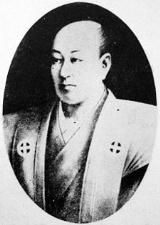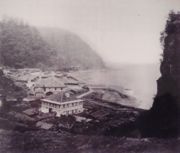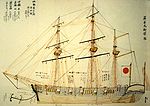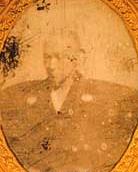
Shimazu Nariakira
Encyclopedia


Daimyo
is a generic term referring to the powerful territorial lords in pre-modern Japan who ruled most of the country from their vast, hereditary land holdings...
) of the Edo period
Edo period
The , or , is a division of Japanese history which was ruled by the shoguns of the Tokugawa family, running from 1603 to 1868. The political entity of this period was the Tokugawa shogunate....
, the 28th in the line of Shimazu clan
Shimazu clan
The were the daimyō of the Satsuma han, which spread over Satsuma, Ōsumi and Hyūga provinces in Japan.The Shimazu were identified as one of the tozama or outsider daimyō clans in contrast with the fudai or insider clans which were hereditary vassals or allies of the Tokugawa clan,The Shimazu were...
lords of Satsuma Domain. He was renowned as an intelligent and wise lord, and was greatly interested in Western learning
Rangaku
Rangaku is a body of knowledge developed by Japan through its contacts with the Dutch enclave of Dejima, which allowed Japan to keep abreast of Western technology and medicine in the period when the country was closed to foreigners, 1641–1853, because of the Tokugawa shogunate’s policy of national...
and technology. He was enshrined after death as the Shinto
Shinto
or Shintoism, also kami-no-michi, is the indigenous spirituality of Japan and the Japanese people. It is a set of practices, to be carried out diligently, to establish a connection between present day Japan and its ancient past. Shinto practices were first recorded and codified in the written...
kami
Kami
is the Japanese word for the spirits, natural forces, or essence in the Shinto faith. Although the word is sometimes translated as "god" or "deity", some Shinto scholars argue that such a translation can cause a misunderstanding of the term...
in May 1863.
Early life and rise to power
Shimazu Nariakira was born at the Satsuma domain's estate in EdoEdo
, also romanized as Yedo or Yeddo, is the former name of the Japanese capital Tokyo, and was the seat of power for the Tokugawa shogunate which ruled Japan from 1603 to 1868...
, on April 28, 1809. He rose to power as daimyō of the domain of Satsuma only after surviving a gruesome and arduous war within his own family and domain, known as the Oyura Sōdō or the Takasaki Kuzure. He faced much opposition in Satsuma since he spent most of his life in Edo; as such he was considered a stranger in his own domain. In his quest to prepare Satsuma for potential Western aggression, he also faced many opposing military schools of thought in Satsuma who disagreed with the Shimazu family’s plan for strengthening coastal defense.
Nariakira did not see eye to eye with his father, Shimazu Narioki
Shimazu Narioki
was a Japanese feudal lord of the Edo period, the 27th in the line of Shimazu clan lords of Satsuma Domain 1809-1851. He was the father of Shimazu Nariakira and Shimazu Hisamitsu....
, or his father’s chief advisor, Zusho Hirosato
Zusho Hirosato
was a Japanese samurai of the late Edo period, who served as karō of the Satsuma Domain. Also known as .-Biography:Zusho was born in the Kagoshima castle town in 1776, the son of Satsuma samurai Kawasaki Motoaki. At age 12 he was adopted by Zusho Kiyonobu; at 22, he was sent to Edo as a tea...
. Both Narioki and Zusho were wary of the Tokugawa shogunate
Tokugawa shogunate
The Tokugawa shogunate, also known as the and the , was a feudal regime of Japan established by Tokugawa Ieyasu and ruled by the shoguns of the Tokugawa family. This period is known as the Edo period and gets its name from the capital city, Edo, which is now called Tokyo, after the name was...
. Zusho also saw many similarities in Nariakira and his grandfather, Shigehide. Shigehide also had a great interest in Dutch studies as well as scientific and industrial projects, which promptly led to the deterioration of the domain’s financial position. Having worked so hard to rehabilitate and strengthen the treasury of Satsuma, Zusho did not encourage Nariakira’s ambitious and costly program for a military build-up. Narioki and Zusho’s mutual disdain and mistrust for Nariakira led to their endeavoring to isolate Nariakira from Satsuma’s affairs, which entailed withholding or all together ceasing the flow from all sources of information regarding Satsuma’s officials or their dealings with the shogunate.
Another formidable and dangerous obstacle for Nariakira in not only his plans to bolster the defenses of all of Japan but also his ascendancy to daimyō of Satsuma was Yura, the mother of his half-brother, Hisamitsu
Shimazu Hisamitsu
Prince , also known as ', was a Japanese samurai of the late Edo period. The younger brother of Shimazu Nariakira, Hisamitsu served as regent for his underage son Tadayoshi , who became the 12th and last lord. Hisamitsu was instrumental in the efforts of the southern Satsuma, Chōshū, and Tosa clans...
. By the time Nariakira had arrived in Satsuma to address a crisis related to the Ryūkyū Kingdom
Ryukyu Kingdom
The Ryūkyū Kingdom was an independent kingdom which ruled most of the Ryukyu Islands from the 15th century to the 19th century. The Kings of Ryūkyū unified Okinawa Island and extended the kingdom to the Amami Islands in modern-day Kagoshima Prefecture, and the Sakishima Islands near Taiwan...
(a vassal state under Satsuma) in 1846, Yura had used her charm to thoroughly convince Narioki to promote the interests of her son Hisamitsu over Narioki’s legitimate son and heir-apparent (Nariakira). Zusho, Narioki, Yura, and Hisamitsu were the key members of the coalition which rallied other Satsuma bureaucrats who felt threatened by Nariakira’s immense and highly intimidating intelligence, and tried to impede all attempts Nariakira made to retire his father as daimyō and take his place.
Nariakira arrived in Satsuma to attempt to resolve the Ryūkyū crisis, as per the orders of shogunal high official Abe Masahiro
Abe Masahiro
was the chief senior councillor in the Japanese government at the time of the arrival of Commodore Matthew Perry. Against the shogun's wishes, and the wishes of many other government officials, he worked to open Japan to the West, signing the Convention of Kanagawa in 1854, and other unequal...
, on June 25, 1846. A French ship had arrived in Ryūkyū in 1844, and two British ships the following year, demanding treaties of amity and commerce; as the kingdom was semi-independent and not generally regarded to be part of Japan proper, this presented a dilemma. Nariakira and Abe Masahiro decided in the end that, despite the shogunate's policies of seclusion, such relations should be allowed in Ryūkyū, rather than risking violent conflict with the Western powers.
On March 8, 1847, Narioki arrived in Satsuma, making Nariakira’s position, something equivalent to deputy to his father, obsolete. After essentially having the reins of power wrenched from his hands by his own father, Nariakira left Satsuma for Edo. The authority formerly vested him was clearly and quickly being shifted to his half brother, Hisamitsu Hisamitsu was rapidly elevated through the ranks of his father’s court soon after Nariakira’s departure from Satsuma for Edo. He was placed in charge of the newly created office of military service of Satsuma in October 1847. In 1848, Narioki appointed Hisamitsu steward of Chosa District, with the responsibility of acting on behalf of the daimyō in all military matters in the area. At about the same time, Hisamitsu was given the highly respected post of han councilor, a rank which, according to the instructions accompanying the appointment, placed him at the top of the social scale. At ceremonial occasions, Hisamitsu was ordered by his father to sit at a place higher than that of the deputy in charge of the daimyō of Satsuma’s castle
Kagoshima Castle
is a Japanese castle in Kagoshima City, Kagoshima Prefecture, Japan. The other name of this castle is Tsurumarujo.-History:This castle was constructed by Shimazu Iehisa in 1601. In 1600 Shimazu Yoshihiro, the father of Iehisa, was defeated at the Battle of Sekigahara as a daimyo of the western...
. Narioki even went so far as to place Hisamitsu in charge of all of Satsuma whenever the daimyō chose to leave Satsuma for any reason, business or pleasure. It was apparent that Hisamitsu was being groomed to become the next daimyō, completely disregarding the fact that, by primogeniture
Primogeniture
Primogeniture is the right, by law or custom, of the firstborn to inherit the entire estate, to the exclusion of younger siblings . Historically, the term implied male primogeniture, to the exclusion of females...
, Nariakira was supposed to be the heir-apparent.
To further discredit and impede Nariakira’s rise to lord of Satsuma, Yura was rumored to have asked at least five spiritual leaders to cast spells on Nariakira’s eldest sons as well as take other measures to curse Nariakira’s children. Many of Nariakira’s followers believed Yura was the source of the subsequent deaths of his eldest children. This belief caused many of them to call for the assassination of Yura, her son Hisamitsu, and Zusho, whom they felt also played a hand in the deaths of Nariakira’s eldest children. Nariakira was able to restrain them; upon hearing of their plans for murder, Narioki began rooting out Nariakira’s supporters and ordering their deaths by seppuku
Seppuku
is a form of Japanese ritual suicide by disembowelment. Seppuku was originally reserved only for samurai. Part of the samurai bushido honor code, seppuku was either used voluntarily by samurai to die with honor rather than fall into the hands of their enemies , or as a form of capital punishment...
.
The conflict had gotten so far out of hand that Nariakira was left with no choice but to request aid from Abe Masahiro. Abe, seeing that Nariakira was being hindered in his proceeding with the Ryūkyū crisis by his own father and family retainers, aided in getting Narioki to retire and removing Zusho.
Abe first went about the task of removing Zusho, who was greatly relied upon by Narioki, by inviting him to Edo. Abe’s stated purpose was a desire to discuss the Ryūkyū crisis and its current handling. In the process of the conversation, Abe began to ask Zusho a line of questioning that made it apparently clear to Zusho that Abe, as well as the Tokugawa shogun, knew the truth of the illegal Satsuma-Ryūkyū-Western trade relations, which were being carried out against the shogunate's policy of seclusion. Zusho’s devotion to Narioki pushed him to take full responsibility for the illicit trade by committing seppuku on December 18, 1848. On December 3, 1850, Narioki was called to Edo by the shogun and presented with a prized set of tea utensils, indicating the shogun's desire for Narioki to retire. On February 3, 1851, Nairoki retired and Shimazu Nariakira was made daimyō of Satsuma.
Love of education and Western culture

In 1812, at age three, Nariakira was designated the heir to the Satsuma lordship by his father. As with any daimyō’s heir, Nariakira was prepared for his future role, by receiving a well-rounded education in the martial and scholarly arts. As stated above, Nariakira shared his grandfather Shigehide’s fascination with Western culture and learning. The young Nariakira was fascinated by his grandfather’s collection of western items, which included clocks, musical instruments, telescopes, microscopes, and weapons. In the course of his education, he was also taught how to read and write Roman letters, and would later use Roman letters to write Japanese words as a personal form of code. Shigehide also introduced Nariakira to Philipp Franz von Siebold
Philipp Franz von Siebold
Philipp Franz Balthasar von Siebold was a German physician and traveller. He was the first European to teach Western medicine in Japan...
, a German physician serving as the director of the Dutch East India Company
Dutch East India Company
The Dutch East India Company was a chartered company established in 1602, when the States-General of the Netherlands granted it a 21-year monopoly to carry out colonial activities in Asia...
(Vereenigde Oostindische Compagnie)in Nagasaki, making him one of the few Japanese to have actually met a Westerner.
After he became daimyō of Satsuma, Nariakira had Minayoshi Hotoku, a Satsuma physician, to build the Iroha-maru, one of the first Western-style ships built in Japan. It was based on Minayoshi’s 6 feet (1.8 m), 3 foot (0.9144 m) model. Nariakira then built a shipyard for Western-style shipbuilding at Sakurajima
Sakurajima
, also romanized as Sakurashima or Sakura-jima, is an active composite volcano and a former island of the same name in Kagoshima Prefecture in Kyūshū, Japan...
. He carried his love of Western culture into the military of Satsuma where he implemented Western-style cavalry and demanded annual military field maneuvers. However, without the Satsuma budget that had been so carefully restored by his enemy Zusho, none of this would have been possible.
He also began enacting educational changes in Satsuma geared at bringing in Western science and technology. Nariakira established the Rangaku Koshujo, a school for the study of the Dutch language and Western culture. He would frequently visit schools and ask students to explain the meaning of the Confucian texts
Chinese classic texts
Chinese classic texts, or Chinese canonical texts, today often refer to the pre-Qin Chinese texts, especially the Neo-Confucian titles of Four Books and Five Classics , a selection of short books and chapters from the voluminous collection called the Thirteen Classics. All of these pre-Qin texts...
, to ensure that their Western learning did not corrupt their sense of nationalism. So strong was Nariakira’s desire to raise well-educated youths that he set aside four koku annually to feed starving scholars, essentially a form of financial aid or scholarship. His goal in promoting education in Satsuma was to make sure the youths of Satsuma were “taught to master themselves, rule their homes wisely, preserve national peace, and trust the universal power.”
In 1848, Shimazu obtained the first daguerreotype
Daguerreotype
The daguerreotype was the first commercially successful photographic process. The image is a direct positive made in the camera on a silvered copper plate....
camera
Camera
A camera is a device that records and stores images. These images may be still photographs or moving images such as videos or movies. The term camera comes from the camera obscura , an early mechanism for projecting images...
ever imported into Japan, and ordered his retainers to study it and produce working photographs. Due to the limitations of the lens used and the lack of formal training, it took many years for a quality photograph to be created, but on September 17, 1857, a portrait of Shimazu in formal attire was produced. This photograph became an object of worship in the (also referred to as Shōkoku Shrine) after Shimazu's death, but it later became missing. Lost for a century, the daguerreotype was discovered in a warehouse in 1975 and was later determined to be the oldest daguerreotype in existence that was created by a Japanese photographer. For this reason, it was designated an Important Cultural Property
Important Cultural Properties of Japan
The term is often shortened into just are items officially already classified as Tangible Cultural Properties of Japan by the Japanese Agency for Cultural Affairs and judged to be of particular importance to the Japanese people....
by the government of Japan
Government of Japan
The government of Japan is a constitutional monarchy where the power of the Emperor is very limited. As a ceremonial figurehead, he is defined by the 1947 constitution as "the symbol of the state and of the unity of the people". Power is held chiefly by the Prime Minister of Japan and other elected...
in 1999, the first photograph ever given this honor.
Associates and death
In the course of his life, Nariakira made many friends in high places. These connections came in handy during his efforts to force the retirement of his father. Abe Masahiro, who at the time was a rōjūRoju
The ', usually translated as Elder, was one of the highest-ranking government posts in Tokugawa Japan. The term refers either to individual Elders, or to the Council as a whole; under the first two shoguns, there were only two Rōjū...
, was one of these friends. Abe spoke on behalf of the Tokugawa shogun in regards to Japan’s national military defense and was the one who placed Nariakira in charge of Satsuma’s dealing with the Ryūkyū Western Trade Treaty crisis.
Abe, and indirectly, the Tokugawa shogun, were disturbed by Nariakira’s removal from responsibility over the Ryūkyū Western Trade Treaty crisis because their policy concerning the crisis was predicated on their trust in him, not in his father or Zusho Hirosato. Narioki and Zusho had already proven themselves untrustworthy by not being completely reliable on matters concerning Ryūkyū. Abe knew that the only way Nariakira could gain control of the Ryūkyū crisis was if his father and Zusho were removed; through Abe’s intervention, this too was accomplished.
Since Narioki and Zusho together ceased the flow of information regarding Satsuma’s officials or their dealings with Ryūkyū to Nariakira, Nariakira had to establish his own information-gathering network. He relied on Date Munenari
Date Munenari
Marquis was the eighth head of the Uwajima Domain during the Late Tokugawa shogunate and a politician of the early Meiji era.-Early life:Munenari was born in Edo, the 4th son of the hatamoto Yamaguchi Naokatsu...
of Uwajima to explain his predicament to the Tokugawa shogunate and Abe. He instructed his associates Yamaguchi Sadayasu and Shimazu Hisataka to gather information in Satsuma for him as well as keep a close watch on Zusho’s activities with special emphasis on goods and money being brought into the domain. Nariakira then decided it was time to make his bid for the lordship of Satsuma. He relied on Date Munenari to report the situation for him and gain the sympathies of Abe. In a letter addressed to Date on August 27, 1848, Nariakira thanks him for obtaining Abe’s assurance that he would overlook Nairoki and Zusho’s transgressions and not take Satsuma to court as long as the Ryūkyū problem was resolved satisfactorily. Date’s correspondence with Abe served to hasten Narioki’s retirement and Nariakira’s ascendancy as daimyō of Satsuma.
Once Nariakira became daimyō, he needed loyal men to ensure that Yura and Narioki’s continued efforts to undermine his power did not succeed. Saigō Takamori
Saigo Takamori
was one of the most influential samurai in Japanese history, living during the late Edo Period and early Meiji Era. He has been dubbed the last true samurai.-Early life:...
, a low-ranking Satsuma samurai, was promoted from assistant clerk, to Nariakira’s attendant, in 1854. Ōkubo Toshimichi
Okubo Toshimichi
, was a Japanese statesman, a samurai of Satsuma, and one of the three great nobles who led the Meiji Restoration. He is regarded as one of the main founders of modern Japan.-Early life:...
was exiled by Narioki for supporting Nariakira, but once Nariakira came to power he was pardoned and rose rapidly through the ranks. Saigō and Ōkubo worked on Nariakira's behalf, speaking with Nariaki
Tokugawa Nariaki
Tokugawa Nariaki was a prominent Japanese daimyo who ruled the Mito domain and contributed to the rise of nationalism and the Meiji restoration.- Clan leader :...
, the lord of Mito
Mito Domain
was a prominent feudal domain in Japan during the Edo period. Its capital was the city of Mito, and it covered much of present-day Ibaraki Prefecture. Beginning with the appointment of Tokugawa Yorifusa by his father, Shogun Tokugawa Ieyasu, in 1608, the Mito branch of the Tokugawa clan...
to convince him to back Nariakira’s view that government should have greater focus on the emperor and less on the shogun. Saigo and Okubo adopted many of Nariakira’s views, which would later become the foundation of the new Meiji government. These views included centralizing the government around the emperor, and Westernizing the Japanese military.
Shortly before his death, Nariakira was left with only a two-year-old son (Tetsumaru) and eight-year-old daughter (Teruhime). He had been forced to ask Narioki to decide between Hisamitsu or Hisamitsu's son Tadayoshi to succeed him as daimyō. Saigō and Ōkubo felt the death of all of Nariakira's viable heirs was caused by Yura and wanted retribution, but Nariakira would not allow it. On July 8, 1858, Nariakira was supervising the joint preparatory maneuvers in Tempozan for sending 3,000 Satsuma soldiers to Edo, and he succumbed to the heat. He was transported to Tsurumaru Castle, where he died on the 16th(from the Biography of Nariakira website). A few years after his death, he was deified as a Shinto kami
Kami
is the Japanese word for the spirits, natural forces, or essence in the Shinto faith. Although the word is sometimes translated as "god" or "deity", some Shinto scholars argue that such a translation can cause a misunderstanding of the term...
, Terukuni-daimyōjin.
Further reading
- Kanbayashi Norimasa 芳即正 (1993). Shimazu Nariakira 島津斉彬. Tokyo: Yoshikawa Kōbunkan 吉川弘文館.

